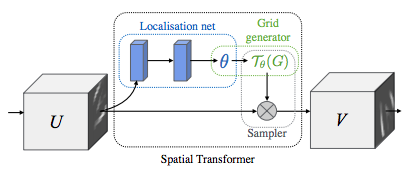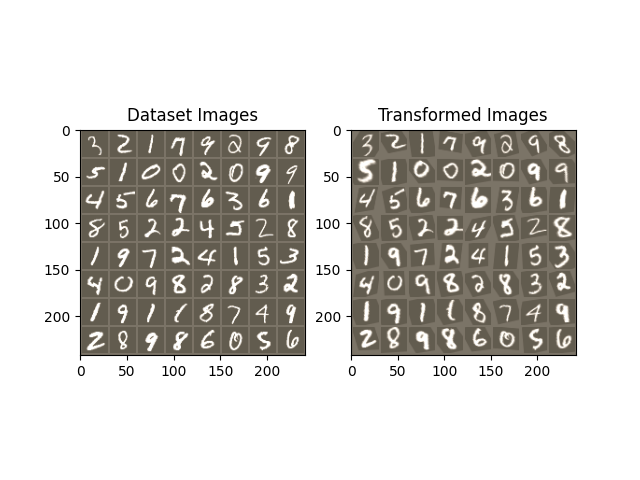


Note
Go to the end to download the full example code.
Spatial Transformer Networks Tutorial#
Created On: Nov 08, 2017 | Last Updated: Jan 19, 2024 | Last Verified: Nov 05, 2024
Author: Ghassen HAMROUNI

In this tutorial, you will learn how to augment your network using a visual attention mechanism called spatial transformer networks. You can read more about the spatial transformer networks in the DeepMind paper
Spatial transformer networks are a generalization of differentiable attention to any spatial transformation. Spatial transformer networks (STN for short) allow a neural network to learn how to perform spatial transformations on the input image in order to enhance the geometric invariance of the model. For example, it can crop a region of interest, scale and correct the orientation of an image. It can be a useful mechanism because CNNs are not invariant to rotation and scale and more general affine transformations.
One of the best things about STN is the ability to simply plug it into any existing CNN with very little modification.
# License: BSD
# Author: Ghassen Hamrouni
import torch
import torch.nn as nn
import torch.nn.functional as F
import torch.optim as optim
import torchvision
from torchvision import datasets, transforms
import matplotlib.pyplot as plt
import numpy as np
plt.ion() # interactive mode
<contextlib.ExitStack object at 0x7f639d3c0790>
Loading the data#
In this post we experiment with the classic MNIST dataset. Using a standard convolutional network augmented with a spatial transformer network.
from six.moves import urllib
opener = urllib.request.build_opener()
opener.addheaders = [('User-agent', 'Mozilla/5.0')]
urllib.request.install_opener(opener)
device = torch.device("cuda" if torch.cuda.is_available() else "cpu")
# Training dataset
train_loader = torch.utils.data.DataLoader(
datasets.MNIST(root='.', train=True, download=True,
transform=transforms.Compose([
transforms.ToTensor(),
transforms.Normalize((0.1307,), (0.3081,))
])), batch_size=64, shuffle=True, num_workers=4)
# Test dataset
test_loader = torch.utils.data.DataLoader(
datasets.MNIST(root='.', train=False, transform=transforms.Compose([
transforms.ToTensor(),
transforms.Normalize((0.1307,), (0.3081,))
])), batch_size=64, shuffle=True, num_workers=4)
0%| | 0.00/9.91M [00:00<?, ?B/s]
100%|██████████| 9.91M/9.91M [00:00<00:00, 122MB/s]
0%| | 0.00/28.9k [00:00<?, ?B/s]
100%|██████████| 28.9k/28.9k [00:00<00:00, 23.1MB/s]
0%| | 0.00/1.65M [00:00<?, ?B/s]
100%|██████████| 1.65M/1.65M [00:00<00:00, 364MB/s]
0%| | 0.00/4.54k [00:00<?, ?B/s]
100%|██████████| 4.54k/4.54k [00:00<00:00, 31.6MB/s]
Depicting spatial transformer networks#
Spatial transformer networks boils down to three main components :
The localization network is a regular CNN which regresses the transformation parameters. The transformation is never learned explicitly from this dataset, instead the network learns automatically the spatial transformations that enhances the global accuracy.
The grid generator generates a grid of coordinates in the input image corresponding to each pixel from the output image.
The sampler uses the parameters of the transformation and applies it to the input image.

Note
We need the latest version of PyTorch that contains affine_grid and grid_sample modules.
class Net(nn.Module):
def __init__(self):
super(Net, self).__init__()
self.conv1 = nn.Conv2d(1, 10, kernel_size=5)
self.conv2 = nn.Conv2d(10, 20, kernel_size=5)
self.conv2_drop = nn.Dropout2d()
self.fc1 = nn.Linear(320, 50)
self.fc2 = nn.Linear(50, 10)
# Spatial transformer localization-network
self.localization = nn.Sequential(
nn.Conv2d(1, 8, kernel_size=7),
nn.MaxPool2d(2, stride=2),
nn.ReLU(True),
nn.Conv2d(8, 10, kernel_size=5),
nn.MaxPool2d(2, stride=2),
nn.ReLU(True)
)
# Regressor for the 3 * 2 affine matrix
self.fc_loc = nn.Sequential(
nn.Linear(10 * 3 * 3, 32),
nn.ReLU(True),
nn.Linear(32, 3 * 2)
)
# Initialize the weights/bias with identity transformation
self.fc_loc[2].weight.data.zero_()
self.fc_loc[2].bias.data.copy_(torch.tensor([1, 0, 0, 0, 1, 0], dtype=torch.float))
# Spatial transformer network forward function
def stn(self, x):
xs = self.localization(x)
xs = xs.view(-1, 10 * 3 * 3)
theta = self.fc_loc(xs)
theta = theta.view(-1, 2, 3)
grid = F.affine_grid(theta, x.size())
x = F.grid_sample(x, grid)
return x
def forward(self, x):
# transform the input
x = self.stn(x)
# Perform the usual forward pass
x = F.relu(F.max_pool2d(self.conv1(x), 2))
x = F.relu(F.max_pool2d(self.conv2_drop(self.conv2(x)), 2))
x = x.view(-1, 320)
x = F.relu(self.fc1(x))
x = F.dropout(x, training=self.training)
x = self.fc2(x)
return F.log_softmax(x, dim=1)
model = Net().to(device)
Training the model#
Now, let’s use the SGD algorithm to train the model. The network is learning the classification task in a supervised way. In the same time the model is learning STN automatically in an end-to-end fashion.
optimizer = optim.SGD(model.parameters(), lr=0.01)
def train(epoch):
model.train()
for batch_idx, (data, target) in enumerate(train_loader):
data, target = data.to(device), target.to(device)
optimizer.zero_grad()
output = model(data)
loss = F.nll_loss(output, target)
loss.backward()
optimizer.step()
if batch_idx % 500 == 0:
print('Train Epoch: {} [{}/{} ({:.0f}%)]\tLoss: {:.6f}'.format(
epoch, batch_idx * len(data), len(train_loader.dataset),
100. * batch_idx / len(train_loader), loss.item()))
#
# A simple test procedure to measure the STN performances on MNIST.
#
def test():
with torch.no_grad():
model.eval()
test_loss = 0
correct = 0
for data, target in test_loader:
data, target = data.to(device), target.to(device)
output = model(data)
# sum up batch loss
test_loss += F.nll_loss(output, target, size_average=False).item()
# get the index of the max log-probability
pred = output.max(1, keepdim=True)[1]
correct += pred.eq(target.view_as(pred)).sum().item()
test_loss /= len(test_loader.dataset)
print('\nTest set: Average loss: {:.4f}, Accuracy: {}/{} ({:.0f}%)\n'
.format(test_loss, correct, len(test_loader.dataset),
100. * correct / len(test_loader.dataset)))
Visualizing the STN results#
Now, we will inspect the results of our learned visual attention mechanism.
We define a small helper function in order to visualize the transformations while training.
def convert_image_np(inp):
"""Convert a Tensor to numpy image."""
inp = inp.numpy().transpose((1, 2, 0))
mean = np.array([0.485, 0.456, 0.406])
std = np.array([0.229, 0.224, 0.225])
inp = std * inp + mean
inp = np.clip(inp, 0, 1)
return inp
# We want to visualize the output of the spatial transformers layer
# after the training, we visualize a batch of input images and
# the corresponding transformed batch using STN.
def visualize_stn():
with torch.no_grad():
# Get a batch of training data
data = next(iter(test_loader))[0].to(device)
input_tensor = data.cpu()
transformed_input_tensor = model.stn(data).cpu()
in_grid = convert_image_np(
torchvision.utils.make_grid(input_tensor))
out_grid = convert_image_np(
torchvision.utils.make_grid(transformed_input_tensor))
# Plot the results side-by-side
f, axarr = plt.subplots(1, 2)
axarr[0].imshow(in_grid)
axarr[0].set_title('Dataset Images')
axarr[1].imshow(out_grid)
axarr[1].set_title('Transformed Images')
for epoch in range(1, 20 + 1):
train(epoch)
test()
# Visualize the STN transformation on some input batch
visualize_stn()
plt.ioff()
plt.show()

/usr/local/lib/python3.10/dist-packages/torch/nn/functional.py:5167: UserWarning:
Default grid_sample and affine_grid behavior has changed to align_corners=False since 1.3.0. Please specify align_corners=True if the old behavior is desired. See the documentation of grid_sample for details.
/usr/local/lib/python3.10/dist-packages/torch/nn/functional.py:5100: UserWarning:
Default grid_sample and affine_grid behavior has changed to align_corners=False since 1.3.0. Please specify align_corners=True if the old behavior is desired. See the documentation of grid_sample for details.
Train Epoch: 1 [0/60000 (0%)] Loss: 2.309120
Train Epoch: 1 [32000/60000 (53%)] Loss: 0.617857
/usr/local/lib/python3.10/dist-packages/torch/nn/_reduction.py:51: UserWarning:
size_average and reduce args will be deprecated, please use reduction='sum' instead.
Test set: Average loss: 0.2984, Accuracy: 9125/10000 (91%)
Train Epoch: 2 [0/60000 (0%)] Loss: 0.808117
Train Epoch: 2 [32000/60000 (53%)] Loss: 0.468103
Test set: Average loss: 0.1288, Accuracy: 9596/10000 (96%)
Train Epoch: 3 [0/60000 (0%)] Loss: 0.235929
Train Epoch: 3 [32000/60000 (53%)] Loss: 0.234212
Test set: Average loss: 0.1140, Accuracy: 9655/10000 (97%)
Train Epoch: 4 [0/60000 (0%)] Loss: 0.344354
Train Epoch: 4 [32000/60000 (53%)] Loss: 0.489010
Test set: Average loss: 0.0798, Accuracy: 9768/10000 (98%)
Train Epoch: 5 [0/60000 (0%)] Loss: 0.324676
Train Epoch: 5 [32000/60000 (53%)] Loss: 0.416067
Test set: Average loss: 0.0935, Accuracy: 9723/10000 (97%)
Train Epoch: 6 [0/60000 (0%)] Loss: 0.260094
Train Epoch: 6 [32000/60000 (53%)] Loss: 0.243994
Test set: Average loss: 0.0639, Accuracy: 9807/10000 (98%)
Train Epoch: 7 [0/60000 (0%)] Loss: 0.204516
Train Epoch: 7 [32000/60000 (53%)] Loss: 0.101330
Test set: Average loss: 0.0880, Accuracy: 9732/10000 (97%)
Train Epoch: 8 [0/60000 (0%)] Loss: 0.243067
Train Epoch: 8 [32000/60000 (53%)] Loss: 0.182981
Test set: Average loss: 0.0520, Accuracy: 9842/10000 (98%)
Train Epoch: 9 [0/60000 (0%)] Loss: 0.061037
Train Epoch: 9 [32000/60000 (53%)] Loss: 0.119666
Test set: Average loss: 0.0602, Accuracy: 9824/10000 (98%)
Train Epoch: 10 [0/60000 (0%)] Loss: 0.115695
Train Epoch: 10 [32000/60000 (53%)] Loss: 0.133578
Test set: Average loss: 0.0487, Accuracy: 9843/10000 (98%)
Train Epoch: 11 [0/60000 (0%)] Loss: 0.193437
Train Epoch: 11 [32000/60000 (53%)] Loss: 0.088614
Test set: Average loss: 0.0647, Accuracy: 9820/10000 (98%)
Train Epoch: 12 [0/60000 (0%)] Loss: 0.146670
Train Epoch: 12 [32000/60000 (53%)] Loss: 0.137681
Test set: Average loss: 0.0585, Accuracy: 9834/10000 (98%)
Train Epoch: 13 [0/60000 (0%)] Loss: 0.119391
Train Epoch: 13 [32000/60000 (53%)] Loss: 0.133004
Test set: Average loss: 0.0899, Accuracy: 9742/10000 (97%)
Train Epoch: 14 [0/60000 (0%)] Loss: 0.188477
Train Epoch: 14 [32000/60000 (53%)] Loss: 0.084831
Test set: Average loss: 0.0531, Accuracy: 9829/10000 (98%)
Train Epoch: 15 [0/60000 (0%)] Loss: 0.271990
Train Epoch: 15 [32000/60000 (53%)] Loss: 0.422313
Test set: Average loss: 0.0402, Accuracy: 9862/10000 (99%)
Train Epoch: 16 [0/60000 (0%)] Loss: 0.242792
Train Epoch: 16 [32000/60000 (53%)] Loss: 0.193368
Test set: Average loss: 0.0399, Accuracy: 9882/10000 (99%)
Train Epoch: 17 [0/60000 (0%)] Loss: 0.128860
Train Epoch: 17 [32000/60000 (53%)] Loss: 0.200796
Test set: Average loss: 0.0358, Accuracy: 9879/10000 (99%)
Train Epoch: 18 [0/60000 (0%)] Loss: 0.084832
Train Epoch: 18 [32000/60000 (53%)] Loss: 0.059482
Test set: Average loss: 0.0395, Accuracy: 9883/10000 (99%)
Train Epoch: 19 [0/60000 (0%)] Loss: 0.057011
Train Epoch: 19 [32000/60000 (53%)] Loss: 0.157047
Test set: Average loss: 0.0466, Accuracy: 9853/10000 (99%)
Train Epoch: 20 [0/60000 (0%)] Loss: 0.314976
Train Epoch: 20 [32000/60000 (53%)] Loss: 0.123048
Test set: Average loss: 0.0750, Accuracy: 9771/10000 (98%)
Total running time of the script: (1 minutes 39.432 seconds)
